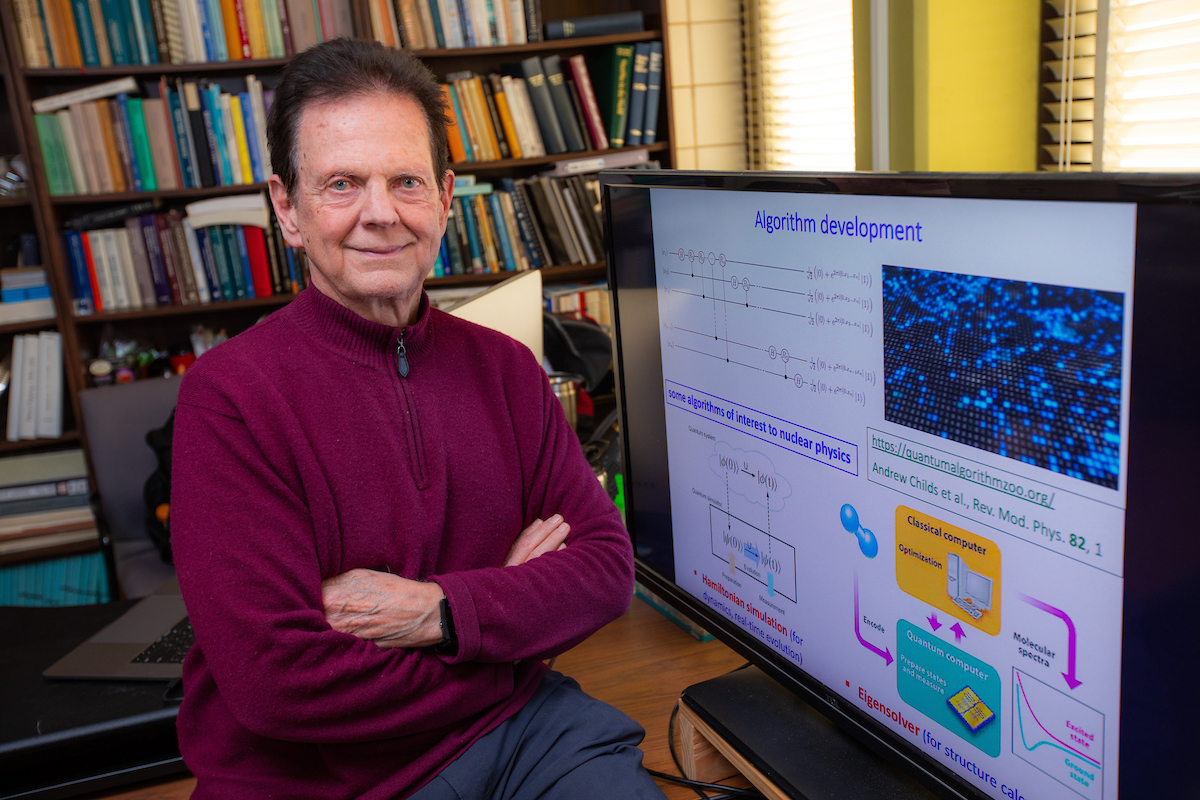
James Vary and his collaborators will transition their simulations of atomic nuclei from high-performance, classical computers to next-generation quantum computers. Larger photo. Photo by Christopher Gannon/Iowa State University.
AMES, Iowa – Let’s see, thought James Vary, how can we have a little fun with the name of our $1 million nuclear physics project?
Hmm, can we work in the term hack?
So, it’s “Nuclei and Hadrons with Quantum Computers.” Or, “NuHaQ,” for short.
“It’s a takeoff on ‘hack,’” said Vary, an Iowa State University professor of physics and astronomy and leader of a new project supported by a three-year, $1 million grant from the U.S. Department of Energy. In academic computing circles, “to be a good hacker is a positive compliment. Hackers love to solve these problems.”
In this case, Vary and the collaborating researchers from Iowa State, Tufts University in Massachusetts and the U.S. Department of Energy’s Lawrence Berkeley National Laboratory in California have some very challenging problems to solve.
They aim to figure out how to use quantum computing – an emerging technology with enormous power, speed and potential – to simulate all the natural forces within an atom’s nucleus.
But don’t we already know a lot about atomic nuclei? After all, it was back in 1911 that Ernest Rutherford (who won the 1908 Nobel Prize in Chemistry for studies of radiation) published a paper with the first description of an atom’s nucleus, discovered when particles hit gold atoms and somehow scattered backward. (Turns out they bounced off the atoms’ dense cores, their nuclei.)
Well, wrote Vary and his colleagues in a project summary, “Atomic nuclei comprise more than 99% of visible matter in the universe yet they are not well understood in terms of the fundamental laws of nature.”
How, for example, did nuclei form in the Big Bang that created the universe? Or how do nuclei form in the processes that create a supernova, a massive, dying, exploding star?
Wanted: Even more computing power
Vary and his colleagues have simulated the forces within nuclei by successfully competing for time on the world’s most powerful supercomputers. That includes “Supercomputer Fugaku” from Japan’s RIKEN Center for Computational Science, a machine ranked No. 2 on the latest “TOP500” ranking of the world’s supercomputers. Between June 2020 and November 2021, it ranked No. 1 on the list published every June and November.
“Our research is at the extreme edge of what classical computers are currently capable of doing,” Vary said. “So, we need to look for that next capability, the next level of computers. We’re always keenly aware of the limits of the computers we’re working with.”
They’ve tried adding some artificial intelligence tools to their work with high-performance computers. While that is beginning to reveal some of the inner workings of the smallest nuclei, it’s also revealing some limits.
“Artificial intelligence has given us a look into the realm we can’t yet enter,” Vary said.
To get there, Vary and his collaborators – Pieter Maris, Glenn Luecke (retired) and Weijie Du (postdoctoral research associate) of Iowa State; Peter Love and Gary Goldstein of Tufts; and Chao Yang of Berkeley Lab – are turning to quantum computing.
“Quantum computing is a game changer,” Vary said of the emerging generation of computing power that’s based on the mechanics and energies at the quantum world’s atomic and subatomic scales. “It’s a totally different realm with potential for immense capabilities far beyond what the current high-performance computers can do.”
Quantum technology means the researchers could have the computing power to begin simulating and studying mid-sized and large atomic nuclei – and their bigger numbers of protons and neutrons.
Vary said the researchers’ first task will be to identify the nuclear physics problems that can help them develop and test quantum computing tools. He said the researchers would work with manufacturers to get access to the newest quantum computers. And then they’ll develop the new step-by-step computational instructions – the algorithms, schemes and codes – required to transition their work to quantum technology.
They’re hoping the work leads to “our ultimate goal of achieving quantum advantage,” the researchers wrote. That would be quantum computers becoming the best tool to model and study nuclei and all the fundamental forces within them. And it would be researchers and students fully utilizing their new quantum tools.
A new hack, indeed.
Contacts
James Vary, Physics and Astronomy, 515-294-8894, jvary@iastate.edu
Mike Krapfl, News Service, 515-294-4917, mkrapfl@iastate.edu
Quick look
Iowa State's James Vary and his collaborators are developing quantum-computing tools to model and study the forces within the nucleus of an atom. A three-year, $1 million grant from the U.S. Department of Energy is supporting the project.
Quote
“Quantum computing is a game changer. It’s a totally different realm with potential for immense capabilities far beyond what the current high-performance computers can do.”
James Vary, physics and astronomy
More news
Find more Iowa State University news and research stories at news.iastate.edu.